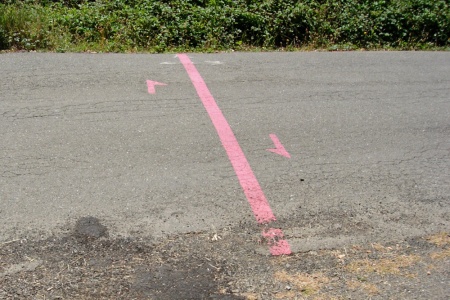My book Deep Oakland: How Geology Shaped a City was released last year on 2 May, so last week marked its anniversary. One reason I wrote it was the one that underlies this blog — to help us more deeply love the ground we stand upon. In the preface I said, “It has features its managers might better heed and others its residents might treasure.”
In my mind Deep Oakland lives in a segment of geoscience called geoheritage, the geological side of a place’s natural and cultural heritage. Geoheritage has its own journal. It also includes a worldwide movement, sadly ignored in this country, that creates formal geoparks under UNESCO. I’ve established a new “geoheritage” category for blog posts that occupy this territory.
With that, let me tell you what I did last week.
Back in 2005, I took part in a memorable field trip to Ward Creek, a Sonoma County locality in the hills above Guerneville that has produced important science since the early 1960s. The local authority who led the trip, Rolfe Erickson of Sonoma State University, said about this spot, “Possibly the most intensely studied body of metamorphic rocks in the world, Ward Creek’s small outcrop is the American standard for glaucophane-bearing metamorphic rocks.” (Glaucophane is the blue-green mineral that lends its color to Oakland’s blueschist.) Ward Creek, in brief, is a prime site of scientific geoheritage, not just a locality of interest but a place of pilgrimage.
However, in the years since 2005 the landowner at that locality has moved on and Rolfe has died. Access to private land can be lost when the human contacts that maintain it are broken. To regain it, the process must be restarted. Some landowners can be beguiled and some reach out on their own; others can never be persuaded.
Recently a new spot on Ward Creek, a few hundred meters downstream, was tentatively opened. The landowner was curious enough to seek a geologist’s insight, and a friendly reconnaissance visit was arranged. I was lucky last week to join that small party of geologists. I brought along three stones I’d collected in 2005 and returned them to their home, close to where I had interrupted their motion downstream.
But that was just a personal, private accomplishment. The overriding goal of the gathering was to see if the site was worthy and to cement warm ties with the owner family sufficient for them to keep welcoming visitors. The visiting party included a veteran field researcher, faculty members from a local college, and a representative of a local geological society, all of us with the same shared goal for our different purposes.
Everyone said the right things, and the site was worthy. It had scenery:
a variety of exotic rock types:
lots of well-exposed bedrock worth mapping in detail:
and plenty of awe inspiration for student and pro alike:
I have high hopes that in the future, well-regulated groups of visitors can experience this place.
An important part of geology isn’t taught in textbooks: the care and feeding of relationships. There are specific bonds between teachers and students, among professionals, between author and reader, between speaker and audience, between masters of past times and moderns who surpass them. I’ve witnessed these many times over the years, but it was a first for me to see links being made between people with different interests in the same precious land — the basic bond of geoheritage.
Oakland, too, has some exceptional localities for geologists and geologizers on the public lands in and around town. They’re the basics of our own geoheritage, and we’re lucky to have them.

















